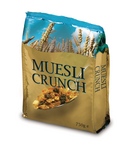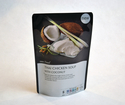Stand-up pouches are sitting pretty
8 June 2012Pouches continue to punch above their weight, offering growing numbers of design and structural options. Paul Gander asks pouch and materials suppliers in Europe and North America what is driving this trend?
You can find stand-up pouches in almost every part of the supermarket, from the coffee aisle to soft drinks, and from pet food to chilled food. The fact that the format is seen by consumers as being convenient, contemporary and sustainably lightweight goes a long way towards explaining its success.
A victim of this very success, though, the pouch is increasingly being pushed in new directions in order to stand out from what is now a crowd.
At supplier of premade pouches Schur Star Systems, systems sales manager Vince Larsen says: “Our focus is on points of difference”. Even though the speed and reliability of inline pouch form-fill-seal (FFS) has moved on considerably over recent years, preformed packs offer advantages both in terms of shape and more complex 3D structure.
Of course, pouch laminates are increasingly differentiated in terms of their structure, too. “For microwavable packs, we might use polypropylene combined with polyesters – sometimes nylon,” says Larsen. “And we’re using triple laminates where a better barrier is required for sterilisation or pasteurisation.”
In this last case, he prefers not to disclose the structure. But as we will see, some laminate suppliers put foil in high barrier retort materials.
For frozen food applications, the pouch laminate can be based on co-extruded polyethylene. Nor are applications restricted to food.
“We extrude our own biodegradable films,” says Larsen. “We now have compostable pouches which can replace flower pots. The project has been three years or so in development.”
To extend shelflife for food, inline gas flushing is an option, says Schur. Laminates can incorporate ethyl vinyl alcohol (EVOH) oxygen barrier for products which do not require heat treatment or, elsewhere, other barriers such as silicon oxide (SiOx).
At materials supplier Huhtamaki, European marketing director for flexibles Gerhard Hartmann emphasises the role played by metal oxide barriers (SiOx, or AlOx – aluminium oxide), particularly when it comes to human food. Brands such as Uncle Ben’s opt for this intermediate level of barrier, he says, but have the benefit of a transparent laminate.
“If customers require a higher level of barrier for retortable pouches, then aluminium foil remains in the lead,” says Hartmann. A thin foil layer is even used on the company’s own Cyclero pouch, or DrinkBag, to give product a year’s shelflife. Here, too, the pack undergoes a pasteurisation process.
“The most demanding retort application is for pet food, where brand owners want the material stability foil provides,” he says.
Pet food also provides an insight into the relative status of inline FFS and separate forming and filling of pouches. “Major brand owners such as Mars and Nestlé use in-house pouchmaking machines, principally for their pet foods, but not inline with the filling,” he says. In most cases, there will at least be a buffering system between the forming and filling stations.
“Manufacturers want the highest possible efficiency on the filling line, which is the most expensive part of the process,” Hartmann explains. “On an FFS line, if the pouchmaking fails, this causes build-up and costly downtime.”
Inline FFS has been growing in some pouch markets such as coffee refill packs, he says. “But standup pouches are the most complex to form and fill inline, especially where there is an integrated zipper.”
At US-headquartered converter Ampac, director of innovation Sal Pellingra makes much of the format’s contemporary appeal. He also argues that many of the more exciting pouch innovations are now happening in North America. “Western Europe is a little further ahead and the format is better accepted,” he concedes. “But there’s now higher growth in the US.”
He explains: “Pouches are just booming. It’s unbelievable the number of categories moving that way. We’re buying one pouch machine every quarter just to keep up.”
Major brand owners such as Heinz and Campbell’s are starting to introduce pouch packaging for their products in the US, says Ampac. “The age profile of people buying product in cans is going up,” says Pellingra. “Pouches offer differentiation.”
So pouches look different, but how do they stack up in cost terms? Premade pouch filling lines can run at speeds of up to 1,000ppm, says Ampac. This will not compete with high volume canning lines, for instance. “But even if the per unit cost is higher, total shipping, storage and even energy costs to sterilise the packs can work out lower,” says Pellingra.
“That said, it’s tough to compete when you require your customer to invest in new equipment.”
There are established options for reclosability, such as zippers, and for easy opening, such as linear tears. “Then there are other options such as easy-tear strips,” says Pellingra. “But the biggest challenge is the added cost these features bring with them, especially at a time when everyone’s looking for cost reductions.”
Earlier this year, Amcor Flexibles announced a partnership with Velcro Europe for the use of the well-known closure system on bags and pouches. The converter claims the system will provide none of the alignment problems associated with zipper closures but, significantly perhaps, chooses not to make any sort of cost comparison.
Cost sensitivity is especially high around retort pouches, where competition with rigid alternatives remains high. Any additional features offering aesthetic, supply chain or ergonomic benefits have to be balanced against the need to keep price-per-pack at a minimum.
Last year, Mondi addressed one key issue with its Anti-Staining Pouch. To existing features such as tear-away opening and standard filling and sealing capabilities, this retortable structure added a significantly higher barrier. According to the company, this means that the laminate blocks grease stains and discolouring, even on white areas, over the full shelf life of the product.
Earlier in 2011, Mondi’s Zip & Valve concept won recognition at the CFIA food industry supplier show awards in France. The idea is that the format combines speed of preparation and convenience with consumer involvement. Water and seasoning is added to taste before the zipper closure is resealed. In the case of this pouch design, the valve – which can be tailored to the needs of the product – is incorporated into the zipper.
A more recent award winner was Ampac’s range of packs for Tesco Finest Soups in the UK. The packaging, produced at the company’s Kirchberg factory in Switzerland, took retort pouches into new territory through the use of 8 and 10-colour flexo printing rather than the more normal gravure process. A Flexible Packaging Association award recognised the high quality of flexo graphics, achieved using urethane inks.
As Mondi’s Zip & Valve demonstrates, pouches can make a strong contribution to the current vogue for ‘interactive’ packs, where the consumer is allowed to take just enough of an active part in the process to think of him or herself as a cook – or a chef.
“We’ve noticed there’s a huge demand for products which require the consumer to contribute to the end result,” says Larsen at Schur. “Our Dual pouch, and other multi-compartment microwaveable pouches, are interactive but also highly functional, in that they make the chef’s job easier.”
This means that components can be cooked for different times, or even in different ways. “It also makes the product look fresher,” he argues. “And you can see exactly what you’re buying.”
Schur’s Trivet and BowlPack formats provide lightweight alternatives to rigid packaging. In the Trivet, the consumer can mix sauce from the lower compartment with product in the upper section.
“We’re mindful of the fact that people want to reduce the weight of their packaging,” says Larsen. “In this case, the Trivet – a pouch with a double base – can replace three items of rigid packaging.”
So while differentiation and standout among pouches is increasingly being looked for, one major plank of the pack’s appeal continues to be its ability to provide light and convenient versions of bulkier types of packaging.
Putting the ‘specific’ into ‘specification’
Developments in flexible packaging generally, and pouches in particular, have been given strong support by the growing ability of materials suppliers to tailor products more precisely and control quality more tightly.
Polyethylene (PE) is often thought of as more of a commodity than a specialist polymer. But as bpi.films shows, its role in high performance laminates is far from ordinary. For the inner sealing film, in particular, performance has to be reliable, says commercial director Mark Vernon.
“A film has to offer excellent sealing qualities in order to maintain pack integrity,” he explains. “To help reduce the presence of gels, which can prevent a hermetic seal being formed, we use specially selected polymers. We also employ extrusion lines equipped with online digital scanning.”
An ability to cope with high speed, automated pouch production lines is of paramount importance. “To reduce the likelihood of stoppages, a film must have a good reel profile and just the right level of slip, which allows the film to move smoothly over the machinery with reduced drag,” Vernon explains. “Too much slip on the treated surface, and this will lead to poor bond strength and possible delamination.”
The overall weight of the pouch laminate can also have a bearing on the choice of PE polymer. “For monolayer films, an octene-rich film is often used, as it allows users to achieve the best sealing range and high strength seal integrity,” he says. “But if the pouch uses a thicker film, octene-lean polymer blends can be ideal, as the seal initiation temperature tends to be slightly lower.”
Schur’s double-bottomed Trivet pouch Trivet pouch SchurStar's principal pouch filling machine SchurStar's filling machine Amcor’s pouches for the Tesco Finest range of soups won awards for their flexo graphics quality Tesco Finest 1 Pack produced by Bpi.films Bpi Huhtamaki’s flexible Cyclero pack for Maxx Cyclero pack for Maxx Schur bowlpack pouch for an Asda prawn salad Schur bowlpack







